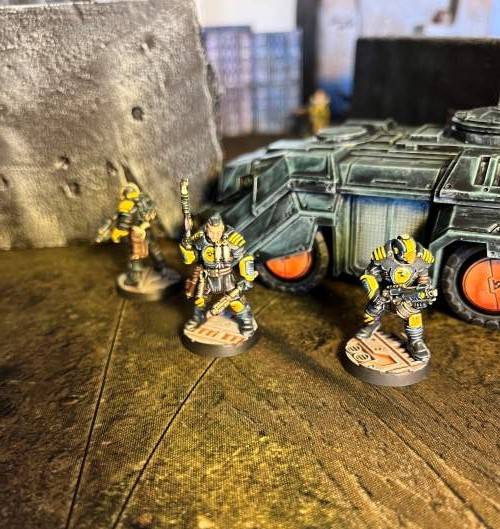In the gritty world of the underhive, where law is loose and loyalty looser, rumors of a rare alien artifact have sent shockwaves through the criminal underworld. This isn’t just any artifact. It’s whispered to bestow immortality on those who use it. The scene is set for a deadly skirmish as gangs scramble to claim it, but there’s a twist: they can’t do it alone. Welcome to The Heist, a skirmish wargame scenario designed to encourage emergent play, where player-driven decisions and interactions take center stage.
This idea builds on a number of gaming sessions where I have been trying to encourage the emergent play of roleplaying games in skirmish wargaming. These examples have all been set in the grimdark Warhammer 40K universe and have been well received by my players. You can read more about these experiences here, here and here. I want to take my lessons learned and create a new multiplayer scenario that maximizes engagement. This is what I’ve come up with:
The Heist Scenario
An Imperial security vehicle has been ambushed and disabled deep in the underhive. Inside, the artifact lies under heavy lock and key, guarded by three security enforcers tasked with guarding it with their lives. But that’s not all—word of the ambush has spread like wildfire, and now multiple gangs are converging on the scene to grab the prize.
However, no gang can unlock the security vehicle on its own. To crack it open, members of two different gangs must be present at the same time. This forces players to navigate temporary alliances while eyeing each other warily—after all, betrayal could be just as profitable.
Adding to the chaos are rad zombies, creatures mutated by the toxic waste of the underhive. They’ll randomly enter the battlefield each turn, keeping players on their toes and preventing anyone from staying static for too long.

Encouraging Emergent Play
Emergent play is all about creating situations where the story unfolds naturally from player decisions, rather than being dictated by strict game rules. In The Heist scenario, this is encouraged through several design elements:
- Gang Identity: Each player will create their gang’s backstory, choosing a name, leader, and reputation. Is your gang known for ruthless efficiency? Or are they a scrappy underdog outfit that’s always two steps behind the bigger players? The identity of each gang will influence their approach to the scenario. Some might bargain and form temporary alliances, while others might rush in guns blazing.
- Forced Cooperation: The artifact cannot be obtained by one gang alone. To unlock the security vehicle, two gangs must cooperate. This creates a natural tension where players must balance collaboration with their need to score points through combat. Will they form fragile truces, or will betrayals happen as soon as the vehicle is open?
- Rad Zombie Threat: The random appearance of rad zombies adds another layer of unpredictability. These threats could push gangs to work together briefly, or they could be a useful distraction, allowing an opportunistic gang to slip in and make a move on the artifact.
- Endgame Choices: The gang that holds the artifact at the end of the game gets a powerful narrative decision—who do they sell it to? Players will choose between an Imperial Inquisitor, a Mysterious Underhive Cult, or an Offworld Rogue Trader Captain, each of which could shape future games. The outcome of this scenario will ripple through the campaign, giving players a sense of consequence and long-term impact.
Victory Points and Competition
To keep things competitive, victory points (VP) are awarded based on a variety of actions:
- Hold the artifact at the end of the game: 15 VP
- Blow open the security vehicle: 10 VP to each gang involved
- Kill an enemy gang leader: 5 VP
- Kill an enemy gang member: 2 VP
- Kill a rad zombie: 1 VP
This scoring system incentivizes a mix of cooperation and conflict. Players need each other to unlock the vehicle and share points, but they also need to eliminate threats to rack up individual points. The shuffling rad zombies, though worth less VP, are ever-present distractions that could make or break a gang’s plans.

The Artifact’s Dark Secret
The alien artifact can be activated, but its effects are unknown to the players. I won’t spoil what happens (just in case any of my players are reading this), but let’s just say turning it on could have major consequences. This secret adds an element of mystery and risk, offering players another decision to weigh—do they risk using it, or play it safe?
The Ruleset: Space Weirdos
As in previous scenarios, I’ll be using the Space Weirdos ruleset, which is perfect for quick and intense skirmishes. Each gang will consist of a leader and two gangers, making the game fast-paced but still strategic. The small team sizes also allow players to focus on individual characters, adding a personal touch to the emergent narratives that unfold.

Emergence and Tension
The beauty of The Heist scenario lies in the tension between cooperation and competition. Gangs must work together to unlock the artifact, but they’re constantly weighing whether it’s worth turning on their temporary allies. Meanwhile, the rad zombies and the looming threat of the artifact’s mysterious power ensure that no plan is ever safe.
This scenario offers a playground for emergent play, where player choices drive the action and create memorable stories. Whether through alliances, betrayals, or desperate last stands, no two games of The Heist scenario will ever be the same. So gather your gang, trust no one, and get ready to fight for (potential) immortality—if you survive long enough to claim it.



